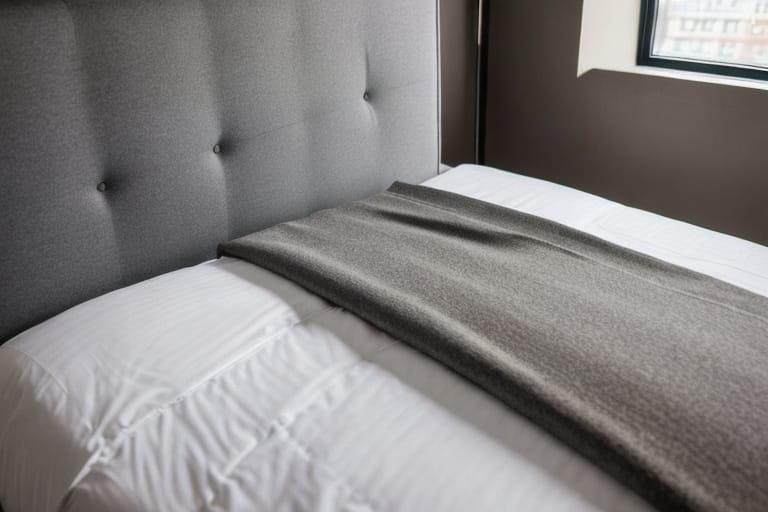So you spilled some coffee on your down comforter – it happens! But now you may be wondering – is it safe to throw my down comforter in the washing machine? Getting the right answer is key to properly caring for your bedding and ensuring its longevity.
This beginner’s guide will provide a complete overview of washing down comforters, with steps for machine washing along with care instructions, expert tips, and common mistakes to avoid. Read on to learn everything you need to confidently clean your down-filled bedding.
What Exactly Are Down Comforters?
Before diving into cleaning, let’s quickly review what defines a down comforter.
- Down comforters are filled with the fine, fluffy clusters and plumage that lie underneath the tougher exterior feathers of ducks and geese. This is what provides the signature softness.
- The fill power indicates the quality of down – higher numbers mean more loft and insulation. Most comforters range from 600 to 800 fill power.
- Common shell fabrics are cotton, cotton sateen, polyester, silk, or rayon. The shell helps contain the fill.
- Popular types of down comforters include goose down, duck down, hypoallergenic, and down alternative varieties.
Why Proper Care and Cleaning Matters
Taking good care of your down comforter will maximize its benefits:
- Extend longevity – With proper maintenance, a quality down comforter can last over 10 years.
- Preserve efficiency – Regular cleaning helps down maintain loft and insulation abilities. As down gets dirty, it becomes less efficient and may mat.
- Prevent buildup – Oils from skin and dirt can accumulate easily in down, reducing coziness and leading to odor.
- Maintain appearance – Soils dull the look of down. Clean items look fresher.
Following the manufacturer’s care instructions is highly recommended to get the most out of your comforter.
General Care and Maintenance Tips
Before looking at washing specifically, there are some general care pointers to keep in mind:
- Fluff frequently – Fluffing helps restore the loft and avoid clumping. Gently shake out and reshape.
- Use a duvet – Enclosing your comforter in a duvet cover protects the shell fabric from soiling.
- Spot clean when needed – Treat spills right away with a damp cloth and mild detergent.
- Air out regularly – Down needs airflow. Hang outdoors when possible.
- Wash at least twice a year – For most households, washing every 6 months is ideal.
Are Down Comforters Machine Washable?
The good news is yes, you can safely machine wash a down comforter – provided that your washer can accommodate a large load and you use the proper settings and detergent.
Washing machines have improved and can gently get down bedding clean as long as care is taken to not agitate it roughly or spin too fast. However, machine drying capacity has not improved as much, making that the trickier part. We’ll get into more details shortly.
First, let’s go over the step-by-step process for washing.
Preparing Your Down Comforter for The Wash
- Check the care label – Follow any special instructions provided by the manufacturer.
- Inspect closures – Make sure all zippers, snaps, tie strings are securely closed so they don’t catch or tangle during the cycle.
- Treat any visible stains – Spot clean pesky areas before placing in the machine so soils don’t spread.
- Select the right detergent – Look for one specially designed for down, wool, or delicates. Standard detergents may be too harsh.
Choosing the Right Machine Wash Settings
- Size matters – Only wash one down comforter at a time so the machine isn’t overloaded. This allows proper water and detergent saturation.
- Water temperature – Warm water helps dissolve oils and soils, but very hot water risks damaging down. Stick to warm/cold settings.
- Gentle cycle – Pick a delicate or gentle/slow setting. The agitation should be light, taking care not to tear seams.
- Extra rinse – An extra rinse ensures all detergent residue gets removed, preventing clumping.
- Low spin speed – High spin speeds can compress down. Opt for the lowest spin if possible or skip this step completely.
The Drying Process is Key
Drying properly is one of the most vital steps since machines can overload down’s structure and moisture invites mildew. There are two main options:
Machine Drying
- Only use the air fluff or no heat delicate setting – Low is still too hot and can burn down clusters.
- Add a couple dry towels – They help absorb moisture and add airflow.
- Use dryer balls – These help separate down and maintain loft.
- Repeat air fluff cycles and reshake down every 20 minutes.
- Budget at least 2 hours for machine drying a king comforter.
Air/Line Drying
- This more gentle approach avoids potential overheating and clumping.
- Lay flat or hang lengthwise to dry – Reshaping several times as it dries.
- Budget 6-12 hours for air drying depending on humidity.
Note: Put your comforter back on the bed slightly damp – Finish drying overnight wrapped in duvet.
Table: Recommended machine wash settings for down comforters
| Cycle | Water Temp | Spin Speed | Dryer Setting |
|---|---|---|---|
| Delicate/Gentle | Cold/Warm | Low / No Spin | Air Fluff No Heat |
Potential Washing Risks and Precautions
While machine washing down comforters is possible, there are a couple of risks to note:
- Clumping – Excess moisture or heat can cause down to compress and lose loft. Follow drying guidelines carefully.
- Damage – Poor quality materials may tear under mechanical stress. Inspect for rips or leaks afterward.
That said, choosing high-quality down items and the right process makes machine washing feasible.

Alternative Cleaning Options
If you decide machine washing your down comforter seems too risky or challenging, other cleaning methods include:
- Dry cleaning – A reputable cleaner can properly wash and dry down bedding. Look for one that does down specifically.
- Spot cleaning – Using a mild detergent, damp cloth, brush, and dryer can freshen areas as needed between deeper cleanings.
- Professionally washing – Some laundromats offer large capacity commercial washers designed for down.
Signs Your Down Comforter is Clean
Once washed, how do you know whether your down comforter was cleaned effectively? Here’s what to check for:
- Fluffy appearance – Clean down should be fully lofty and pillowy, not flattened or clumpy at all.
- No lingering odors – A light, fresh scent is expected at first. Any musty or chemical smells mean it didn’t rinse properly.
- Evenly distributed fill – Shake out and inspect that down still looks evenly dispersed with no bare spots.
Common Machine Washing Mistakes
To achieve down comforter washing success, avoid these pitfalls:
- Overloading the washer – One comforter max leaves room for cleaning mechanics.
- Using regular detergent – Harsh chemicals lead to residue and clumping.
- Skipping the rinse – Detergent buildup causes lumpiness once dry. Always rinse twice.
- Line drying in direct sunlight – The sun’s UV rays can damage fabric and fade colors.
Addressing Common Concerns
Washing down items elicits some typical worries – let’s discuss a few major ones:
Allergies
- Frequent hot water washing kills dust mites. Opt for hypoallergenic covers if severe allergies.
Cost
- At $3-5 per wash, professional cleaning adds up. But correctly machine washing at home saves substantially long-term.
Environmental Impact
- Look for down awarded the “Responsible Down Standard” label. This indicates ethical sourcing practices.
Deciphering Those Confusing Care Labels
Manufacturers include care instructions on tags based on the materials used. Here’s what some common down comforter care symbols mean:
- Machine wash, delicate cycle
- Use non-chlorine bleach only
- Tumble dry low
- Cool iron if needed
Following individual specifications trumps general guidelines for best maintenance. When in doubt, reach out to the brand with questions.
Storing and Replacing Your Down Comforter
To expand your investment in a down comforter, utilize these additional care tips:
Storage
- Store flat or loosely folded in breathable cotton to maximize loft and prevent clumping.
- Use cedar blocks/sachets to repel insects like carpet beetles that feed on feathers.
- Store in cool, dark spaces away from humidity and heat to avoid the growth of bacteria or mildew over time.
Replacement
- Plan to replace your down comforter every 5-10 years depending on quality and care. Premium down bedding exceeds 10 years.
- Signs to retire a comforter include Loft deterioration, holes/rips, thinning fabric, stubborn odors, and visible stains.
- Consider making old down comforters into inserts for new duvet covers.
Expert Care and Cleaning Guidance
For some final tips from the pros, down associations advise:
“With the proper front-loading washer and air-dried correctly, most fine washable down items can be washed effectively at home without excessive shrinkage or damage.” – International Down and Feather Bureau
Independent scientists also recommend skipping fabric softeners and dryer sheets when washing down as the phthalates and fragrances they contain affect insulation and cause clumping.

The Bottom Line
So can you machine wash that favorite down comforter? Yes – if you select the proper delicate cycle, low spin, down-specific detergent, and air fluff dry setting. Patience is mandatory as well to preserve that cloud-like coziness for the long run.
Now that you know the complete ins and outs of machine washing down comforters properly – as well as alternatives for cleaning – you can keep your bedding plush for years. Just be sure to reference any included manufacturer’s guidelines too.
Frequency Asked Questions
What is the best way to clean a down comforter at home?
The recommended way to clean a down comforter at home is to machine wash on a gentle cycle in cold or warm (not hot) water, using a detergent specially formulated for down and delicates. Be sure to use an extra rinse cycle to fully remove detergent residue. Either tumble dry on an air fluff, no heat delicate cycle OR air/line dry fully before putting back on the bed.
Can I put my down comforter in the dryer after washing?
Yes, you can put your down comforter in the dryer after washing but ONLY on an air fluff or no heat delicate cycle. Standard dryer heat will damage down filling and lead to shrinkage or clumping. Add a couple clean towels to help absorb moisture and use dryer balls to separate and re-fluff if machine drying.
How often should you wash a down comforter?
Most experts recommend washing your down comforters at least twice per year or every 6 months. Wash more frequently if you sweat excessively or have indoor pets that sleep on the bed. Frequent washings also help reduce dust mites within down bedding.
What happens if you don’t wash your down comforter enough?
Not washing your down comforter regularly allows body oils, dirt, dust mites, and other allergens to accumulate. This can lead to reduced efficiency, odor buildup, discoloration, and generally feeling less fresh and hygienic. It’s best to clean down bedding at least every 6 months.
Can down comforters go in the washing machine?
Down comforters can go in washing machines safely as long as you use the right settings – a gentle/delicate cycle in cold or warm water on the lowest or no spin speed. Be sure to use a detergent specially designed for delicates like down and feathers to prevent damage.
Should you wash a down comforter before use?
Yes, it’s highly recommended to wash any new down comforter before first use to remove excess down feathers and dust that may have accumulated during shipping or storage. This also helps the down fully expand and loft to its potential ahead of use.
What do you put in the dryer with a down comforter?
If machine drying your down comforter, add a couple clean cotton towels to help absorb moisture faster. You can also add wool or fabric dryer balls to help separate and re-fluff the down fill during the air fluff cycle. Reshake and rotate the comforter every 20 minutes while drying.








